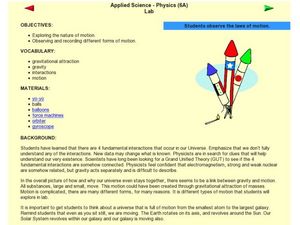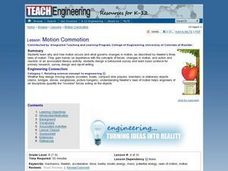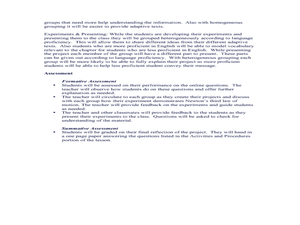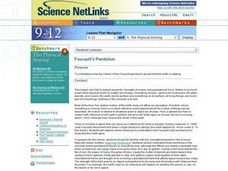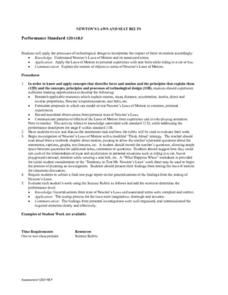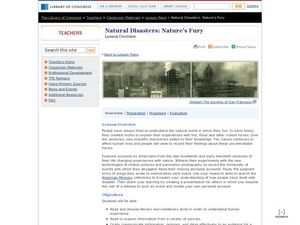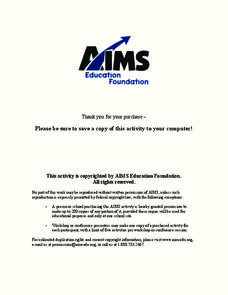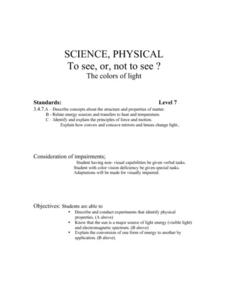Curated OER
Motion Experiment
Learners experiment with the laws of motion. In this motion instructional activity, students explore Newton's Laws of Motion. Learners work in groups experimenting with different objects and observing different types of motion.
Curated OER
A Multimedia Presentation to Describe Newton's Laws of Motion
Eighth graders use various sources to find pictorial evidence of Newton's laws of motion in everyday life. They use various sources of technology to import those pictures into a multimedia presentations.
Curated OER
Science: Motion Commotion
Students examine Newton's three laws of motion to discover what causes it and how it changes. They conduct motion experiments by building catapults and constructing balloon rockets. Finally, they conduct peer studies correlating...
Curated OER
Isaac Newton's Third Law of Motion
Ninth graders experiment with Isaac Newton's Third Law of Motion. In this Third Law of Motion lesson, 9th graders develop an experiment that shows their understanding of this theorem. They work in small groups to read an article at a...
Curated OER
Angular Momentum (Automaticity)
Second graders experience practicing with a wide variety of vocabulary terms that relate to the Vista/Module "Angular Momentum:" momentum, inertia, force; motion, direction, centripetal force; angular momentum, gyroscope, resist. They...
Curated OER
Leonardo Lives
Learners investigate the concepts of force and motion. They describe how motion is created by force. Also students define a simple machine and the factors of application to creating force or motion. They analyze the plans of Leonardo De...
Curated OER
Multimedia to Learn Textbook Science
Pupils work in cooperative groups to produce multimedia presentations to explain how the movement of a yo-yo. Students research information about force and motion and relate it to the movement of the yo-yo.
Curated OER
Rolling Down Hill
Students perform an experiment, collect, and analyze data of a rolling marble down a ramp. They report results after they complete their experiment. Students are assessed in science and writing.
Curated OER
Force and Gliders
Young scholars explore physics by creating data graphs in class. In this flight properties lesson, students read the book Flying Machine and identify the force, resistance and construction necessary to keep a glider in the air. Young...
Curated OER
Foucault's Pendulum
Students investigate how the motion of the Foucault pendulum proves that the Earth is rotating. They research the Internet about pendulums and conduct an experiment online. They view a multimedia presentation about pendulums and read...
Curated OER
Newton's Laws and Seat Belts
Students study Newton's Laws of Motion. They review an assessment task and rubric and discuss Newton's Laws of Motion. They discuss how to test the relationships of mass and acceleration in personal situations. They write a one-page...
Curated OER
The Science of Hurricanes
Students are introduced to the science of hurricanes in an effort to highlight how forces change the speed and direction of motion.
Curated OER
Forces and Energy Study Guide
Sixth graders use prior knowledge to create a tri-fold study guide using Microsoft Publisher (if available). They include real world examples that show balanced and unbalanced forces, kinetic and potential energy, and vocabulary. The...
Curated OER
Natural Disasters: Nature's Fury
Pupils explore the human experience. In this business ethics instructional activity, students analyze primary sources to develop an understanding of the American natural disasters of the 19th and 20th centuries and the implications they...
Curated OER
Ahimsa as a Moral Force
Students explore the concept of Ahimsa. In this peace and tolerance lesson plan, students discuss Gandhi's application of Ahimsa and Satyagrah as they view the motion picture titled, "Gandhi." Students also discuss how effective...
Columbus City Schools
Totally Tides
Surf's up, big kahunas! How do surfers know when the big waves will appear? They use science! Over the course of five days, dive in to the inner workings of tidal waves and learn to predict sea levels with the moon as your guide.
Curated OER
The Physics of Toys
Learners explore physics by experimenting with classic toys. In this physical science instructional activity, students utilize gliders, energy balls, bouncing balls, marbles and other toys to explore how they work. Learners explore each...
Curated OER
Sound Waves
Students explore sound. For this "sound" science lesson, students define sound and explain how sound travels. Students experiment with paper cups and string to conclude how sound travels. Students research a chosen aspect of sound with a...
Curated OER
Simple Machines
Students explain how simple machines work and design their own machine. They use the Internet for research.
Curated OER
Catch the Pollution
Explore environmental care by conducting a pollution experiment. You'll discuss the causes of pollution in our environment and what the overall impact will be if we can't change our ways. Clear plastic tape, a can, and compass are used...
Curated OER
Hurricanes 1: The Science Of Hurricanes
Students are introduced to the science of hurricanes in an effort to highlight how forces change the speed and direction of motion. They list facts about hurricanes; including insights about the formation, movement, and impact hurricanes...
Curated OER
Kites: Patang - The Indian Fighter Kite
Young scholars investigate the history of fighter kites and build their own. In this aeronautics lesson plan, students discover how other countries utilize fighter kites and where they originated. Young scholars create their...
Curated OER
Blow and Go
Students discover how air can move things by using their breath. In this physics lesson plan, students hypothesize then attempt to move a pencil 1 meter using nothing but their breath. Students record data from their experiment including...
Curated OER
To See or Not to See: The Colors of Light
Seventh graders describe and conduct an experiment that identifies the physical properties of light. They explore sources of visible light and an electromagnetic spectrum. Students explain the conversion of one form of energy to another.
